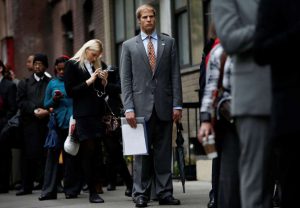APRIL 16, 2020

A record 22 million Americans have sought unemployment benefits over the past month, with millions more filing claims last week, underscoring the deepening economic slump caused by the novel coronavirus outbreak.
Thursday’s weekly jobless claims report from the Labor Department followed dismal data on Wednesday showing a record drop in retail sales in March and the biggest decline in factory output since 1946. Economists are predicting the economy, which they believe is already in recession, contracted in the first quarter at its sharpest pace since World War Two.
Weekly jobless claims, the most timely data on the economy’s health, are being closely watched for clues on the depth of the downturn, when the waves of layoffs may let up and when a recovery might start.
“The fact that 22 million individuals have filed for unemployment benefits in just four weeks shows that the labor market has entered a traumatic period,” said Lydia Boussour, a senior U.S. economist at Oxford Economics in New York.
Initial claims for state unemployment benefits dropped 1.370 million to a seasonally adjusted 5.245 million for the week ended April 11, the government said. Data for the prior week was revised to show 9,000 more applications received than previously reported, taking the tally for that period to 6.615 million. A total 22.034 million people have filed claims for jobless benefits since March 21.
The Labor Department said the coronavirus outbreak “continues to impact the number of initial claims.” Economists are divided on whether the second straight weekly decline in claims suggests that filings peaked at a record 6.867 million in the week ended March 28, or that overwhelmed state employment offices were unable to process the flood of applications.
“We expect that claims will remain very elevated in coming weeks as states struggle to clear backlogs and more companies lay off workers in response to the shutdown,” said Joseph Briggs, an economist at Goldman Sachs in New York.
“Including this week, we currently project an additional 20 million in initial jobless claims through the end of May, after which we expect new claims to fall to levels consistent with prior recessions.”
U.S. stock index futures jumped as investors focused on the second straight weekly drop in claims. The dollar was higher against a basket of currencies. U.S. Treasury prices rose.
ECONOMY CONTRACTING
States and local governments have issued “stay-at-home” or “shelter-in-place” orders affecting more than 90% of Americans to control the spread of COVID-19, the respiratory illness caused by the virus, and abruptly halting economic activity. Retail sales and production at factories tanked in March.
Economists are estimating the economy contracted as much as 10.8% in the first quarter, which would be the steepest drop in gross domestic product since 1947. They say a historic $2.3 trillion fiscal package, which made provisions for cash payments to some families and boosted unemployment benefit checks, will likely provide little cushion for the economy.
Economists say the economy entered recession in March.
The National Bureau of Economic Research, the private research institute regarded as the arbiter of U.S. recessions, does not define a recession as two consecutive quarters of decline in real GDP, as is the rule of thumb in many countries. Instead, it looks for a drop in activity, spread across the economy and lasting more than a few months.
Thursday’s claims report also showed the number of people continuing to receive benefits after an initial week of aid surged 4.530 million to a record 11.976 million in the week ending April 4.
The so-called continuing claims data is reported with a one-week lag and is viewed as a better gauge of unemployment. Economists expect the unemployment rate in April will blow past the Great Recession’s peak of 10.0% and the post-World War Two high of 10.8% touched in December 1982.
Courtesy/Source: Reuters










































































































